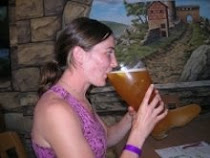We just received a package from Midwest Supplies. It included 2 new 1 gallon jugs. We wanted to try some wine, however we didn't want to go the 5 gallon route. So we thought that these could allow us to experiment a little bit more. It look as though our "brew couple" Tim and Kalli, have also purchased some experimentation vessels as well.
We started off with 4 bottles of Full Circle organic blueberry juice. The starting gravity on just the juice was 1.068. We figured that most of that sugar is likely simple sugar, it should ferment nearly all of it, leaving us with a FG close to 1.000. This would leave us with a ABV between 8 and 9%. The achohol tolerance of this yeast was I believe around 14%, so the juice should ferment out completely dry. We rehydrated our Lalvin D47 yeast, and threw it in the vessel with the juice. We figured we would not have to boil the juice because it came sealed in its containers. Low and behold less then 12 hours later. Our airlocks are bubbling away! We hope to eventually arrest the yeast after we've reached our FG, and then sweeten it up. (We both are not a fan of dry wine).

We also racked our Red Ale to its secondary fermenter. The final gravity ended up being 1.012. Unfortunately this is just a point or two higher then our expected FG. Beer Smith gave us our ABV of 4.7%, however the beer tasted quite watered down. Apparently others have seen this with the Brewers Best Red Ale Kit. However, I know we steeped the grains long enough. We shall see. I've read that a lot of times uncarbonated beer can taste quite thin. It has 2 weeks at least in the secondary and then 3 in bottles, so hopefully the flavor will shine through with age.
I've been reading more and more about the Kolsch style ales. Come to find out the proper way to age this beer is pretty much to lager it after the fermentation is complete. This will give you the true flavor of this beer. For our Kolsch though, we've had it in the secondary for over two weeks at room temperature. Since we're already so excited about this beer, we're not going to lager it. Instead, I've ordered the grains and malts, and we are going to try to replicate the beer, however this time, I'll lager it in the new fridge. This way in a few months, we can compare the beers to find out how the flavor changes from the lager. We'll
When we racked the Kolsch out of the primary I did notice a appley sort of flavor at last taste (It tastes like Budweiser). This is usually a sign of acetaldehyde. This will hopefully be converted out to ethanol, and this flavor will mellow out. We shall see though. The Kolsch gets bottled next week.
Also next week, we're going to start a batch of Edwort's Apfelwein. This recipe has produced over 12,000 gallons on the Home Brew Talk Forums, so I have to try it. Everyone raves about it.
Prost!
Jeremy






I really like the blog so far... good to hear about everything. So eloquent too! Two things I really like are: the incorporation of links into the text... I need to learn that trick. Secondly, I like the idea of the comparing the lagering method versus the room temp fermentation. A concern I have, and maybe its unfounded, is that the juice used in the blueberry wine may have had some wild yeast strains in it. If its true... they could potentially hijack the fermentation and create certain off flavors. However, I used a similar method with my Apfelwein and it produced tasty results, regardless of the presence of wild yeast.
ReplyDeleteAwesome job!
Taxford